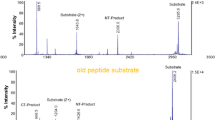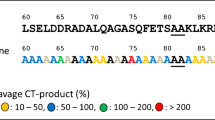Abstract
The application of mass spectrometry (MS) to detect unique peptide markers has been widely employed as a means of identifying bacterial proteins. Botulinum neurotoxins (BoNTs) are bacterial proteins that cause the life-threatening disease botulism. BoNTs are divided into several antigenically distinct serotypes and several dozen subtypes. The toxins’ molecular heterogeneity makes their detection highly challenging. In this study, we describe a new LC–MS/MS-based platform for the direct identification of proteins derived from various species and subspecies in a single assay, as exemplified by BoNTs. The platform employs a rational down-selection process through several steps based on a combination of bioinformatics, tryptic digestion, and LC–MS, each leads to the final panel of markers. This approach has been demonstrated for all 8 subtypes of botulinum serotype A (BoNT/A). Ab-independent and Ab-dependent assays were developed based on the identification of 4 rationally selected markers or a combination of some of them, which enables full selectivity coverage. The Ab-independent assay, which is highly simple and rapid, has a sample-to-result turnaround time of approximately 40 min and enables the identification of 500 MsLD50/mL (5 ng/mL) BoNT/A in complex environmental matrices. The Ab-dependent assay, which is based on toxin’s specific enrichment, has a turnaround time of 100 min, but enables improved sensitivity (50 MsLD50/mL, 0.5 ng/mL). Both assays were verified and validated using various environmental samples. This approach can easily be expanded to other botulinum serotypes and exhibits the potential for even further extension as a highly multiplexed assay for protein-based toxins, viruses, and organisms.






Similar content being viewed by others
Availability of data and materials
The datasets generated are available from the corresponding author on reasonable request.
References
Barash JR, Arnon SS (2014) A novel strain of Clostridium botulinum that produces type B and type H botulinum toxins. J Infect Dis 209:183–191. https://doi.org/10.1093/infdis/jit449
Barr JR et al (2005) Botulinum neurotoxin detection and differentiation by mass spectrometry. Emerg Infect Dis 11:1578–1583. https://doi.org/10.3201/eid1110.041279
Björnstad K, Tevell Åberg A, Kalb SR, Wang D, Barr JR, Bondesson U, Hedeland M (2014) Validation of the Endopep-MS method for qualitative detection of active botulinum neurotoxins in human and chicken serum. Anal Bioanal Chem 406:7149–7161. https://doi.org/10.1007/s00216-014-8170-4
Cheng LW, Stanker LH (2013) Detection of botulinum neurotoxin serotypes A and B using a chemiluminescent versus electrochemiluminescent immunoassay in food and serum. J Agric Food Chem 61(3):755–760. https://doi.org/10.1021/jf3041963
Dong M, Yeh F, Tepp WH, Dean C, Johnson EA, Janz R, Chapman ER (2006) SV2 is the protein receptor for botulinum neurotoxin A. Science (New York, NY) 312:592–596. https://doi.org/10.1126/science.1123654
Dorizas A, Krueger N, Sadick NS (2014) Aesthetic uses of the botulinum toxin. Dermatol Clin 32:23–36. https://doi.org/10.1016/j.det.2013.09.009
Doxey AC, Mansfield MJ, Montecucco C (2018) Discovery of novel bacterial toxins by genomics and computational biology. Toxicon 147:2–12. https://doi.org/10.1016/j.toxicon.2018.02.002
Dressler D, Dirnberger G (2001) Botulinum toxin antibody testing: comparison between the immunoprecipitation assay and the mouse diaphragm assay. Eur Neurol 45:257–260. https://doi.org/10.1159/000052139
Duracova M, Klimentova J, Fucikova A, Dresler J (2018) Proteomic methods of detection and quantification of protein toxins. Toxins. https://doi.org/10.3390/toxins10030099
Hallis B, James BA, Shone CC (1996) Development of novel assays for botulinum type A and B neurotoxins based on their endopeptidase activities. J Clin Microbiol 34:1934–1938. https://doi.org/10.1128/jcm.34.8.1934-1938.1996
Hanna PA, Jankovic J (1998) Mouse bioassay versus Western blot assay for botulinum toxin antibodies: correlation with clinical response. Neurology 50:1624–1629. https://doi.org/10.1212/wnl.50.6.1624
Hatheway CL (1988) Botulism in Laboratory diagnosis of infectious diseases. In: Principles and practice Springer-Verlag Volume I: bacterial, mycotic, and parasitic diseases, pp 111–133, https://doi.org/10.1212/wnl.50.6.1624
Johnson EA, Montecucco C (2008) Botulism. Handb Clin Neurol 91:333–368. https://doi.org/10.1016/s0072-9752(07)01511-4
Jones RG, Liu Y, Rigsby P, Sesardic D (2008) An improved method for development of toxoid vaccines and antitoxins. J Immunol Methods 337:42–48. https://doi.org/10.1016/j.jim.2008.05.009
Kalb SR, Goodnough MC, Malizio CJ, Pirkle JL, Barr JR (2005) Detection of botulinum neurotoxin A in a spiked milk sample with subtype identification through toxin proteomics. Anal Chem 77:6140–6146. https://doi.org/10.1021/ac0511748
Kalb SR, Moura H, Boyer AE, McWilliams LG, Pirkle JL, Barr JR (2006) The use of Endopep-MS for the detection of botulinum toxins A, B, E, and F in serum and stool samples. Anal Biochem 351:84–92. https://doi.org/10.1016/j.ab.2006.01.027
Kalb SR, Krilich JC, Dykes JK, Lúquez C, Maslanka SE, Barr JR (2015) Detection of botulinum toxins A, B, E, and F in foods by endopep-MS. J Agric Food Chem 63:1133–1141. https://doi.org/10.1021/jf505482b
Klaubert B, Vujtovic-Ockenga N, Wermter R, Schad K, von Meyer L (2009) Determination of botulinum toxins after peptic sample pre-treatment by multidimensional nanoscale liquid chromatography and nano-electrospray ion-trap mass spectrometry Journal of chromatography B. Anal Technol Biomed Life Sci 877:1084–1092. https://doi.org/10.1016/j.jchromb.2009.02.053
Kull S et al (2010) Multiplex detection of microbial and plant toxins by immunoaffinity enrichment and matrix-assisted laser desorption/ionization mass spectrometry. Anal Chem 82:2916–2924. https://doi.org/10.1021/ac902909r
Lindsey CY, Smith LA, West MW, Boles JW, Brown JE (2003) Evaluation of a botulinum fragment C-based ELISA for measuring the humoral immune response in primates. Biologicals 31:17–24. https://doi.org/10.1016/s1045-1056(02)00074-x
Loman NJ, Pallen MJ (2015) Twenty years of bacterial genome sequencing. Nat Rev Microbiol 13:787–794. https://doi.org/10.1038/nrmicro3565
Morineaux V, Mazuet C, Hilaire D, Enche J, Popoff MR (2015) Characterization of botulinum neurotoxin type A subtypes by immunocapture enrichment and liquid chromatography-tandem mass spectrometry. Anal Bioanal Chem 407:5559–5570. https://doi.org/10.1007/s00216-015-8707-1
Palace J, Nairne A, Hyman N, Doherty TV, Vincent A (1998) A radioimmuno-precipitation assay for antibodies to botulinum A. Neurology 50:1463–1466. https://doi.org/10.1212/wnl.50.5.1463
Pellett S, Tepp WH, Clancy CM, Borodic GE, Johnson EA (2007) A neuronal cell-based botulinum neurotoxin assay for highly sensitive and specific detection of neutralizing serum antibodies. FEBS Lett 581:4803–4808. https://doi.org/10.1016/j.febslet.2007.08.078
Rosen O, Feldberg L, Dor E, Gura S, Zichel R (2017ab) Optimization of SNAP-25-derived peptide substrate for improved detection of botulinum A in the Endopep-MS assay. Anal Biochem 528:34–37. https://doi.org/10.1016/j.ab.2017.04.012
Rosen O, Feldberg L, Shamai T, Dor E, Barnea A, Weissberg A, Zichel R (2017ba) Development of a multiplex Endopep-MS assay for simultaneous detection of botulinum toxins A, B and E. Sci Rep 7:14859. https://doi.org/10.1038/s41598-017-14911-x
Schiavo G, Matteoli M, Montecucco C (2000) Neurotoxins affecting neuroexocytosis. Physiol Rev 80:717–766. https://doi.org/10.1152/physrev.2000.80.2.717
Sharma SK, Ferreira JL, Eblen BS, Whiting RC (2006) Detection of type A, B, E, and F clostridium botlinum neurotoxins in foods by using an amplified enzyme-linked immunosorbent assay with digoxigenin-labeled antibodies. Appl Environ Microbiol 72(2):1231–1238. https://doi.org/10.1128/AEM.72.2.1231-1238.2006
Sobel J (2005) Botulism clinical infectious diseases: an official publication of the Infectious Diseases Society of America. Clin Infect Dis 41:1167–1173. https://doi.org/10.1086/444507
Stern D et al (2018) A lipid-binding loop of botulinum neurotoxin serotypes B, DC and G is an essential feature to confer their exquisite potency. PLoS Pathog 14:e1007048. https://doi.org/10.1371/journal.ppat.1007048
Turton K, Chaddock JA, Acharya KR (2002) Botulinum and tetanus neurotoxins: structure, function and therapeutic utility. Trends Biochem Sci 27:552–558. https://doi.org/10.1016/s0968-0004(02)02177-1
van Baar BL, Hulst AG, de Jong AL, Wils ER (2002) Characterisation of botulinum toxins type A and B, by matrix-assisted laser desorption ionisation and electrospray mass spectrometry. J Chromatogr A 970:95–115. https://doi.org/10.1016/s0021-9673(02)00508-3
Wang D, Baudys J, Kalb SR, Barr JR (2011) Improved detection of botulinum neurotoxin type A in stool by mass spectrometry. Anal Biochem 412:67–73. https://doi.org/10.1016/j.ab.2011.01.025
Wang D et al (2012) Subtyping botulinum neurotoxins by sequential multiple endoproteases in-gel digestion coupled with mass spectrometry. Anal Chem 84:4652–4658. https://doi.org/10.1021/ac3006439
Wang H et al (2016) A novel peptidomic approach to strain typing of clinical Acinetobacter baumannii isolates using mass spectrometry. Clin Chem 62:866–875. https://doi.org/10.1373/clinchem.2015.253468
Wang H et al (2017a) A genoproteomic approach to detect peptide markers of bacterial respiratory pathogens. Clin Chem 63:1398–1408. https://doi.org/10.1373/clinchem.2016.269647
Wang H et al (2017b) Peptide markers for rapid detection of KPC carbapenemase by LC-MS/MS. Sci Rep 7:2531. https://doi.org/10.1038/s41598-017-02749-2
Wictome M et al (1999) Development of an in vitro bioassay for Clostridium botulinum type B neurotoxin in foods that is more sensitive than the mouse bioassay. Appl Environ Microbiol 65:3787–3792. https://doi.org/10.1128/aem.65.9.3787-3792.1999
Williamson CH et al (2016) Comparative genomic analyses reveal broad diversity in botulinum-toxin-producing Clostridia. BMC Genom 17:180. https://doi.org/10.1186/s12864-016-2502-z
Acknowledgements
We would like to thank Dr. Sandy Livnat for editorial assistance.
Funding
The work was supported by Israel Institute for Biological Research grant no. SB 242.
Author information
Authors and Affiliations
Contributions
OR and LF designed the in vitro studies, performed the in vitro experiments and the instrumental experiments, analyzed the data and wrote the manuscript; ED performed the experiments; RZ designed the in vitro studies, and manuscript overview.
Corresponding authors
Ethics declarations
Conflict of interest
The authors declare no conflict of interest.
Additional information
Publisher's Note
Springer Nature remains neutral with regard to jurisdictional claims in published maps and institutional affiliations.
Supplementary Information
Below is the link to the electronic supplementary material.
Rights and permissions
About this article
Cite this article
Rosen, O., Feldberg, L., Dor, E. et al. New approach for the rational selection of markers to identify botulinum toxins. Arch Toxicol 95, 1503–1516 (2021). https://doi.org/10.1007/s00204-021-02996-3
Received:
Accepted:
Published:
Issue Date:
DOI: https://doi.org/10.1007/s00204-021-02996-3




